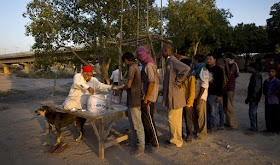Arvind Subramanian, India’s chief economic
adviser, is backing plans for a universal basic income scheme that could
transform poverty rates
By Michael
Safi
 |
|
People wait in a queue to receive food handed
out in New Delhi. A universal
basic income is being considered in India to
tackle mass poverty.
Photograph: Saurabh Das/AP
|
“No power on earth can stop an idea whose
time has come,” the former Indian prime minister Manmohan Singh famously said
in 1991, alluding to Victor Hugo, as he announced the market reforms that are
credited with improving the lives of hundreds of millions of Indians.
Last week, India’s chief economic adviser
used the same language to laud a policy that promises to shrink poverty rates
even further.
A universal basic income (UBI) – in its
simplest form, the idea of paying every citizen a no-strings wage – was also
“an idea whose time has come”, said Arvind Subramanian. Although in this case,
innovation came with a caveat, Subramanian adding: “Perhaps not for immediate
implementation, but at least for serious discussion.”
India is not alone in considering such a
major rethink in the relationship between citizens and the economy. In January,
Finland launched a trial programme to pay some unemployed Finns a guaranteed
sum of €560 (£480) a month – even if they went on to find work. Cities in Italy
and the Netherlands are running similar experiments, and in Scotland, Glasgow
is considering a pilot.
But the transformative potential championed
by UBI advocates has particular appeal in a country such as India, where one in
five people lives below the $1.90 (£1.51) poverty line, 1 million join the
workforce each month, and a clunky, corrupt bureaucracy oversees nearly 1,000
separate welfare schemes.
There have already been Indian trials. Three
years ago, in nine villages in Madhya Pradesh state, 6,000 people were each
given a monthly payment of up to 300 rupees an adult, and half that much for
every child, over a period of 18 months.
Every six months, the impact of the payments
was assessed against 12 villages that received no income, just the usual
government welfare. “What we saw were huge improvements in nutrition, health,
schooling and sanitation,” said Guy Standing, a British economist who helped
run the trials.
Results published afterwards showed the
consumption of lentils, chickpeas and other pulses increased tenfold. Villagers
ate six times more meat and the uptake of fresh vegetables grew 888%. That
meant residents of the village were healthier, worked harder and attended
school more often.
Equity between more socially dominant members
of the community – traditionally the gatekeepers to resources – and the less
powerful also improved, Standing said. “Women benefited more than men, the
disabled benefited more, and scheduled [lowest] castes benefited more than
others.”
India’s government is clearly enamoured by
the idea. Subramanian suggested even Gandhi would approve. He praised the basic
income’s potential to reduce poverty “in one fell swoop”, to relieve the grinding
stress of hunger, and empower Indians to make their own life choices.
Criticisms – such as the idea people would fritter the money on alcohol or
drugs, or drop out of the workforce – he dismissed based on past research.
On paper, the sums also add up. Subramanian
calculates that the annual income required to enable all but the very poorest
Indians to escape penury is about 7,620 rupees (£90) a year. If that sum were
given to 75% of India’s billion-plus population, it would cost about 5% of GDP.
India’s vast welfare schemes and subsidies
for food, petrol and fertilisers are notoriously wasteful and poorly targeted.
Cutting them entirely would save about 2% of GDP. Reducing “middle class”
subsidies on things such as railway tickets and gold would save another 1%. The
rest of the savings might be found in scrapping other government schemes, which
altogether cost 3.7% of GDP.
It would be even cheaper if the basic income
were targeted at women, for example, or if the wealthy – those who own cars or
air conditioners – were excluded, or asked to opt out.
Giving Indian women a minimal basic income
would cost just over 1% of GDP, but have “large multiplier effects” on the
entire society, Subramanian said.
Where the scheme gets tricker – one of the
reasons for calls for discussion of a universal income, rather than
implementation – are the “last mile concerns”. More than 40% of Indians still
lie outside the reach of formal banking. The same rural areas where poverty
levels are starkest might also be those furthest away from bank branches or
cash machines. The logistics of getting money to them would need to be thrashed
out.
And then there is the largest obstacle. Even
with Gandhi on side, it turns out there is a power on earth that can stop an
irresistible idea: politics, and the difficulty of peeling away subsidies from
powerful constituencies.
Asked about the viability of a universal
basic income on Wednesday, the Indian finance minister, Arun Jaitley, said it
was a “wonderful idea”. “The difficulty is that India’s politics [have] not
matured,” he said.
“You will have a demand that we must keep the
subsidies coming, and bring in a universal basic income as well. If politics
can mature then [the] idea will be brilliant.”